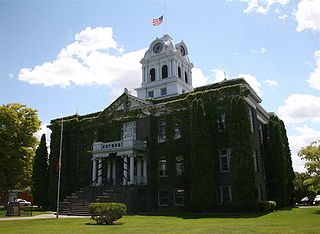
Crook County is one of the 36 counties in the U.S. state of Oregon. As of the 2010 census, the population was 20,978. The county seat is Prineville. The county is named after George Crook, a U.S. Army officer who served in the American Civil War and various Indian Wars.

Prineville is a city in and the seat of Crook County, Oregon, United States. It was named for the first merchant located in the present location, Barney Prine. The population was 9,253 at the 2010 census.
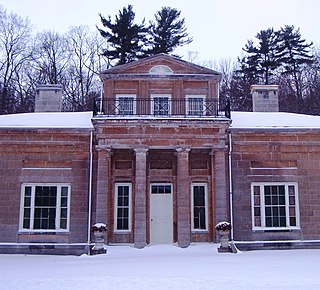
Hyde Hall is a neoclassical country mansion designed by architect Philip Hooker for George Clarke (1768–1835), a wealthy landowner. The house was constructed between 1817 and 1834, and designed with English and American architectural features. It was designated a National Historic Landmark in 1986 for its architecture, and the completeness of its architectural documentary record. It is one of the few surviving works of Philip Hooker, a leading 19th-century American architect.

Hyde School is a historic Romanesque Revival school at 100 High Street in Lee, Massachusetts. The school was built in 1894 from locally quarried marble. It is named for Alexander Hyde, who established the town's first school in his house on West Park Street, and was built on the site of the town's first public school.
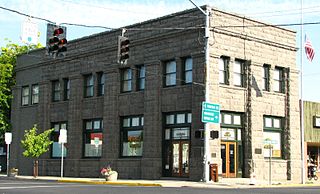
The A. R. Bowman Memorial Museum is a local history museum in Prineville, Oregon, United States. Opened in 1971, the museum is housed in the old Crook County Bank Building which is listed on the National Register of Historic Places. The museum is run by the Crook County Historical Society and highlights the history of Crook County and central Oregon. Its collection includes many original pioneer artifacts, a large railroad exhibit, ranching and timber industry displays, furniture, garments, and historic photographs. The museum also has a research library.

The Crook County Bank is a historic bank building in Prineville, Oregon, United States. It was built in 1910 using stone blocks from a local quarry. The building was first use as a bank and then occupied by title and insurance business until 1971, when ownership was transferred to Crook County for use as a local history museum. Today, the Crook County Bank building is the home of the A. R. Bowman Memorial Museum. Because of its importance to the history of Prineville, the Crook County Bank Building is listed on the National Register of Historic Places.

Camp Warner was a United States Army outpost in south-central Oregon, United States. Camp Warner was located at two different sites approximately 35 miles (56 km) apart. The Army called both sites Camp Warner. However, the first site became known as Old Camp Warner. It was used as winter quarters in 1866–1867 and then abandoned. The second, more developed site is generally known as Fort Warner, although the Army never officially designated it as a fort. Fort Warner was used as a supply depot and administrative headquarters from 1867 to 1874 during a protracted Army campaign against Northern Paiute bands in Eastern Oregon and Northern California. Today, nothing remains of either Old Camp Warner or Fort Warner.
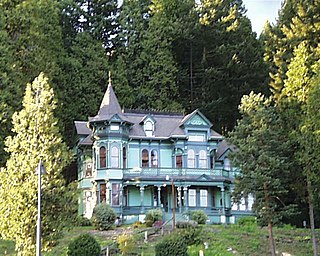
Walter David Pugh was a prominent architect in Salem, Oregon, United States.

The Old Astoria City Hall, now known as the Clatsop County Historical Society Heritage Museum, is a historic building located in Astoria, Oregon, United States, that is listed on the National Register of Historic Places. The building served as the city hall of Astoria from 1905 until 1939. It was the first location of the Columbia River Maritime Museum, from 1963 to 1982, and has been the Heritage Museum since 1985.

The Morrow County Courthouse is a building in Heppner in the U.S. state of Oregon. Built in 1902–03, it was listed on the National Register of Historic Places in 1985. It was among the early commissions of architect Edgar M. Lazarus.
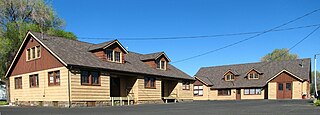
The Lamonta Compound – Prineville Supervisor's Warehouse is a complex of buildings and related infrastructure owned an operated by the Ochoco National Forest in Prineville, Oregon, United States. Built by the Civilian Conservation Corps in 1933–1934, it is the headquarters for field operations in the national forest and is typical of projects carried out by the CCC on behalf of the Forest Service. It represents that era's shift in the Forest Service's architectural vision toward comprehensive site planning, as well as its policy evolution from custodial superintendence of the national forests toward active natural resource management.

The Thomas M. Baldwin House is a historic house located in Prineville, Oregon, United States. It is noted for its association with Baldwin, as well as for its architectural values.
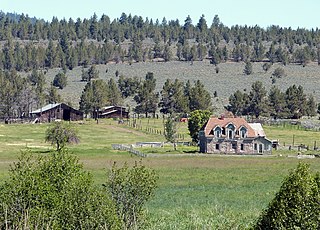
The Roba Ranch is a pioneer ranch located near the small unincorporated community of Paulina in Crook County, Oregon. The ranch is named for George and Mary Roba, sheep ranchers who acquired the property in 1892. Most of the important ranch buildings were constructed by the Roba family between about 1892 and 1910. Today, the ranch covers 1,480 acres (6.0 km2) and is privately owned. The ranch was listed on the National Register of Historic Places in 2007.
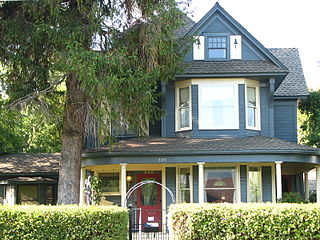
The Marion Reed Elliott House is a historic house in Prineville, Oregon, United States. Built in 1908, it is the largest and best-preserved Queen Anne style house in Prineville. It is also significant as one of a handful of surviving structures that were built by prominent local contractor Jack Shipp (1858–1942). Marion Elliott (1859–1934), an educator and successful attorney, lived in the house from its construction until his death. Both men's careers benefited from the economic boom that occurred in Prineville in the first decades after railroads began reaching Central Oregon around 1900, the period when the Elliott House was built.

The Cline Buttes are mountains with volcanic origins that form three dome-shaped peaks located in Deschutes County in central Oregon. They are some of the eastern foothills of the Cascade Range. Situated on land administered by the Bureau of Land Management, the buttes are flanked on the east and west sides by two separate sections of the Eagle Crest Resort. On the highest summit, there is a Federal Aviation Administration site with an aircraft navigation beacon. The mountains have several hiking trails as well as a number of popular mountain bike routes.

Francis Barnett Prine was an American pioneer who was one of the first settlers to homestead in the Ochoco country of central Oregon. When he was young, Prine traveled with his family from Missouri to Oregon's Willamette Valley over the Oregon Trail. He served in the 1st Oregon Volunteer Infantry Regiment during the American Civil War. Prine later moved to the Central Oregon, where he established several businesses in what became Prineville, Oregon, a town named in his honor.

Cass Adelbert Cline was an American pioneer who was an early settler in central Oregon. Cline’s family moved to Oregon when he was a small child, settling west of the Cascade Mountains near Roseburg. As a young man, Cline moved to central Oregon and claimed homestead land along the Deschutes River. He later became a well-known dentist, property developer, and race horse breeder. Today, a waterfall on the Deschutes River, a nearby mountain group, and a state park bear his name.



















